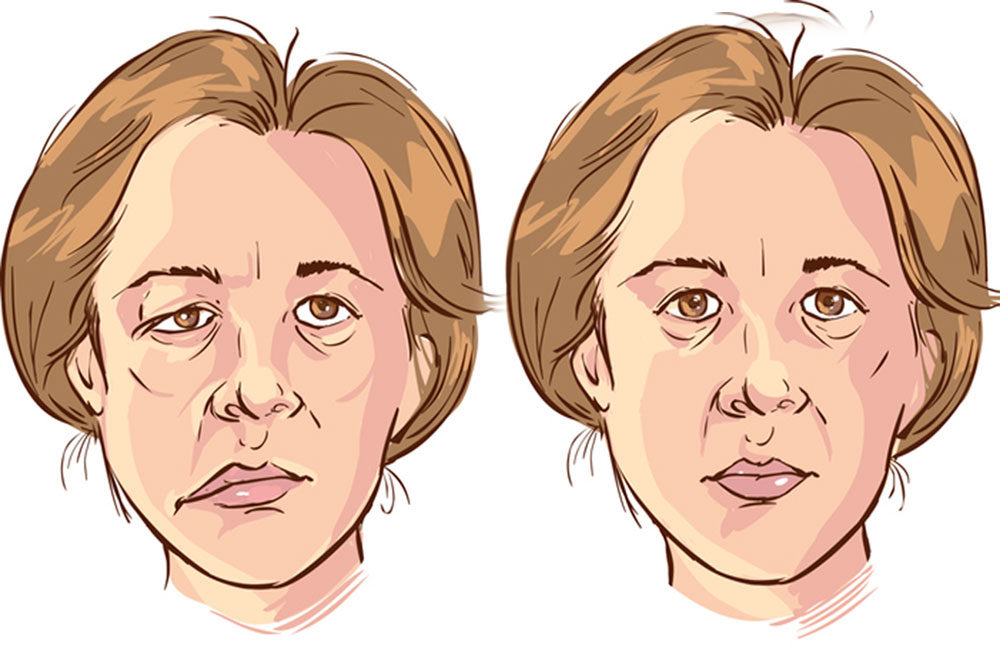
iStock
IMAGINE FEELING well enough for daily activities—except that one side of your face droops, involuntarily produces smiles or squints, contracts, or stiffens to the point of becoming immobile and expressionless. You may also drool or shed crocodile tears (tears with no emotional cause).
Sudden drooping or stiffening of one side of the face could be a worrisome early sign of stroke. But a stroke causes muscle weakness in other parts of the body as well, hence the early stroke-detection method FAST that includes raising both arms. Also, a stroke rarely affects the forehead or eye.
Paralysis that arises suddenly, affects only one side of the face and worsens over 48 hours often signals Bell’s Palsy. The condition affects about one in 60 people during their lifetime, and is becoming more prevalent, possibly related to increasing rates of herpes zoster infection.
Incidence of Bell’s palsy increased to almost 40/100,000 during 2000-2010, compared to 25/100,000 in the years 1968-1982. Although Bell’s Palsy is considered idiopathic (no known cause), herpes infection is present in most cases.
Bell’s palsy also arises after infection with the flu or Lyme disease, in pregnant women, and in those with type 2 (usually adult-onset) diabetes. Bell’s palsy is more common between the ages of 15 and 60, with peak incidence around age 40.
Swelling in the facial nerve leads to ischemia, a restriction of blood and oxygen to the nerve cells. What’s also called the 7th cranial nerve has so many functions that any disruption can lead to an array of symptoms that vary from person to person.
Bell’s palsy can include pain (often behind one ear or headache), loss of taste, and hypersensitivity to sound (hyperacusis). Some sufferers cannot close the eye on the affected side, even during sleep. A rare symptom, synkinesis—when facial muscles move in tandem—can cause simultaneous smiling and blinking.
The label “refrigeration palsy” comes from the common memory among sufferers, soon before symptoms begin, of “cooling of the face or a cold draught,” or exposure to cold, such as driving or sleeping with a window open in cold weather.
Bell’s palsy rates were higher during the cold seasons in a two-year study of active-duty military service members, who have a higher incidence of almost 43 cases/100,000, perhaps due to their unlimited access to free health care.
In this group, climate that was both cold and arid appeared to increase risk, although incidence was higher in the southern region of the United States than elsewhere. Also, sufferers spent more time indoors than the “lower-injury group,” leading to the hypothesis that dry indoor air—heated but not humidified—could “traumatize mucus membranes… in turn, induce reactivation of the herpes virus.”
In this study, incidence increased with age—twice as high for those in the oldest group compared with the youngest—and was higher for females than males and married personnel than their unmarried counterparts.
Facial-nerve paralysis dates back at least 4,000 years, based on representations in Egyptian sculptures, and asymmetrical and distorted faces appear in paintings from the Middle Ages and Renaissance. The uneven smile of Mona Lisa’s portrait has been the subject of facial-nerve symposium presentations.
Stress and high blood pressure may play a role in setting off symptoms. During her separation from Brad Pitt in 2017, Angelina Jolie developed Bell’s palsy along with hypertension, and believed sessions of acupuncture helped her recover. Other famous sufferers include George Clooney, Roseanne Barr and Sylvester Stallone.
If stress plays a role in the cause of Bell’s palsy, it is exacerbated for sufferers when symptoms arise and have no clear end point. Most cases resolve within two weeks although some take several months, and 90% recover completely.
Treatment for more serious symptoms can include oral acyclovir starting within three days of the first symptoms, along with steroids to reduce inflammation. And Botox has helped speed recovery from the drooping.
—Mary Carpenter
Every Tuesday, well-being editor Mary Carpenter reports on health news you can use.
